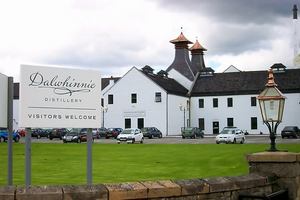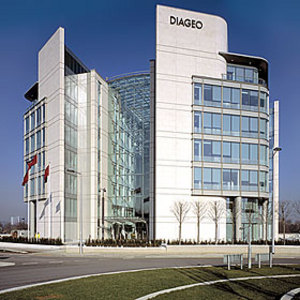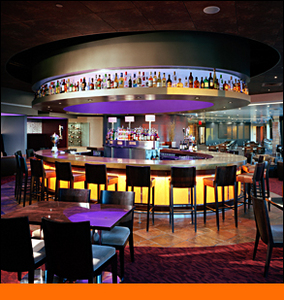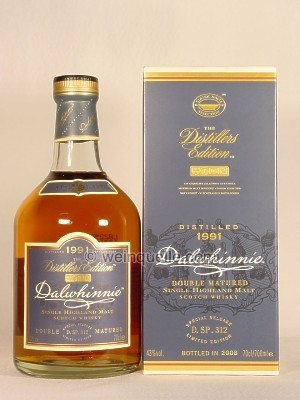|
|
Release Notes
Crafted from pure mountain water flowing 2,000 feet above sea level, Dalwhinnie embodies the gentle spirit of the Highlands, offering delicate floral aromas, whispy hints of heather, and a soft subtle finish. The distiller's edition is matured in oloroso sherry casks to create a spicy, peaty malt with sherry sweetness and a dry finish. The nose shows fresh sherry embraces the maltier, more honeyed aspects of Dalwhinnie. Peaty and surprisingly, still heathery. Spicy yet grapey. The palate has a big, spicy buzz, followed by an impressive build up of very clear, well defined malt. After a quick burst of sweetness, a rich, grape effect then moves in towards the middle. The finish has tons of oak. Very, very dry, with vanilla dominating.
K&L Wine Merchants
Finished in fresh Oloroso Sherry casks, this is a very different proposition to the normal Dalwhinnie, with extra depth and sweetness in addition to the normal Dalwhinnie characteristics.
The Whisky Exchange
The Distillery: Dalwhinnie
| Established: 1897 |
| Silent since: False |
| Address: Dalwhinnie, Inverness-shire PH19 1AB, UK |
| → website |
2002 - A 36 years old official bottling of Dalwhinnie is launched. A 29yo successor was released in 2003.
The Dalwhinnie distillery is located in the Inverness-shire or Strathspey area in the western Highlands, but according to some sources it is a Speyside distillery. Dalwhinnie was built in 1897 by the Strathspey Distillery Co Ltd. under the guidance of the investors John Grant, Alex Mackenzie and George Sellar. The bill for the construction work was just 10,000 pounds.
Dalwhinnie is now owned by UDV, part of Diageo plc. For a long time the only available expressions were the standard 15yo and the "Distiller"s Edition" (double matured). Around 2003, 29yo and 36yo versions were released. I must admit that I haven"t tried these yet because, quite frankly, I"m not the biggest Dalwhinnie fan around.
After the Glenkinchie 10yo, the Dalwhinnie 15yo is my least favourite classic malt. It"s just a little too smooth and friendly for my tastes. But that"s just my personal opinion; many of my friends LOVE the stuff and I have to admit it"s the perfect dram to pour for people who are used to drinking blends because it shows the finesse, smoothness and depth of single malts versus blends without becoming too extreme for "beginners".
The DCL first tansffered Dalwhinnie to J.& G.Stewart Ltd. and then to SMD (for Scottish Malt Distilleries) in 1930. Four years later, in February 1934, Dalwhinnie was seriously damaged by a fire and it took another four years to bring the distillery back to life again. Dalwhinnie"s two stills started producing whisky again in 1938 and keeps doing so relatively undisturbed for the next few decades. The maltings are decommissioned in 1968 but it isn"t until a complete refurbishment in 1986 that the large stills at Dalwhinnie fall (temporarily) silent again.
Oddly enough Dalwhinnie was refurbished again in 1992 - to the tune of 3,2 million pounds. A visitor centre was opened as well. Despite the major refurbishments, Dalwhinnie still uses worm tubs to cool the fresh spirit from the still, just like Cragganmore, Glenkinchie, Oban and Talisker.

Production at Dalwhinnie started in February 1898 - but the owners soon encountered finacial problems and the original name "Strathspey" was changed to "Dalwhinnie" when it was sold to new owners; the aptly named Dalwhinnie Distillery Co. (The Strathmill distillery is on the other side of Speyside...)
The young distillery had to endure quite a few changes during the early 1900"s, including some improvements made by famous architect Charles Doig and more changes in ownership. In 1919 Macdonald Greenlees & Williams Ltd."s bought Dalwhinnie, but just a few years later (in 1926, to be precise) Macdonald Greenlees were themselves bought by the DCL. Nevertheless, the name Greenless appeared on bottles until at least the early 1980"s - perhaps even later.
Dalwhinnie is one of Diageo"s six "Classic Malts", along with Cragganmore, Glenkinchie, Lagavulin, Oban and Talisker. (These six "classic malts" have now been integrated in a larger portfolio called "Classic Malts Selection). Out of the original six distilleries, five still use worm tubs - a fairly old fashioned technique for cooling the vapours and fresh spirit that has just condensed at the top of the still. A few malt maniacs had the chance to inspect working worm tubs at Edradour in 2003 and on the roof of Oban in 2005.
In the new Millenium
2008 - The full production capacity at the distillery is implemented for the first time in quite a while. The number of "mashes" was increased by 50% from 10 to 15 mashes per week. Virtually all malt whisky that is produced at Dalwhinnie is used for Diageo"s own whiskies; independent bottlings are very hard to find.
Trivia:
- Dalwhinnie was part of Diageo"s original series of 6 classic "Classic Malts", together with Cragganmore, Glenkinchie, Lagavulin, Oban and Talisker. This series was first released in 1988. Around 2005 a bunch of other distilleries were added to the range of "classic malts"; Caol Ila, Cardhu, Clynelish, Glen Elgin, Glen Ord, Knockando & Royal Lochnagar.
- Dalwhinnie is one of almost two dozen malt whisky distilleries that were founded over a century ago during the "whisky boom" of the late 19th century and which have managed to survive until this day. The other survivors include Aberfeldy, Ardmore, Aultmore, Balvenie, Benriach, Benromach, Bruichladdich, Bunnahabhain, Dufftown, Glendullan, Glenfiddich, Glenrothes, Glentauchers, Knockandu, Knockdhu, Longmorn, Tamdhu and Tomatin.
- Dalwhinnie distillery has two racked warehouses with room for 5,000 casks of maturing Scotch whisky.
- In 1905 the Dalwhinny distillery was bought by an American company for the friendly price of 1,250 GBP. Cook & Bernheimer from New York were the very first foreign owners of a Scottish distillery.
from Malt Madness
The Owner: Diageo
| Established: 1997 |
| Silent since: False |
| Address: 8 Henrietta Place, London, W1G ONB, UK |
| → website |
Diageo also distributes Unicum, its lighter-bodied variant Zwack and Jose Cuervo tequila products in North America. However, Cuervo operates as a separate company in Mexico and is not owned by Diageo. Similarly Grand Marnier is distributed by Diageo in many markets, including exclusively in Canada, and a deal was reached in 2009 to significantly expand this partnership in Europe.
Furthermore, Diageo owns the Gleneagles Hotel.

Diageo was formed in 1997 from the merger of Guinness plc and Grand Metropolitan plc. The creation was driven by the two executives Anthony Greener and Philip Yea at Guinness plus George Bull and John McGrath of Grand Metropolitan. The product portfolios of Guinness and Grand Met were largely complementary with little overlap.
Diageo is the world"s biggest whisky producer with 28 malt distilleries and two grain distilleries.The company operates the Scotch whisky distilleries of Auchroisk, Benrinnes, Blair Athol (situated at Pitlochry), Caol Ila, Cardhu, Knockando, Glen Elgin, Clynelish, Cragganmore, Dalwhinnie, Glenkinchie, Glen Ord, Lagavulin, Oban, Royal Lochnagar, Strathmill, Talisker, Teaninich, Mannochmore, Mortlach and Glenlossie, which are sold not only under their own name but used to make the various blended scotch whiskies sold by the company, and owns the stock of many closed distilleries such as Port Ellen, Rosebank, Brora, Convalmore, Glen Albyn, North Brechin, Banff, and Linlithgow. The company have opened a new malt distillery adjacent to their maltings at Roseisle (1st new make spirit produced Spring 2009). This will be one of the largest malt distilleries in Scotland. The new building contains 14 traditional copper pot stills. An expansion programme is also underway at its Cameron Bridge Grain Distillery in Fife that will make it the largest grain distillery in Scotland. Diageo also owns the Port Dundas Grain Distillery in Glasgow, and jointly operates the North British Grain Distillery in Gorgie, Edinburgh, with The Edrington Group.

Diageo plc (LSE: DGE, NYSE: DEO) is the largest multinational beer, wine and spirits company in the world. The company is listed on the London Stock Exchange and has American Depositary Receipts listed on the New York Stock Exchange. The word Diageo was formed from the Latin dia (day) and the Greek geo (World), symbolising the use of the company"s brands every day, everywhere. Its head office is located in the City of Westminster in London. It is a constituent of the FTSE 100 Index.
Trivia:
- In December 2003, Diageo provoked controversy over its decision to change its Cardhu brand Scotch whisky from a single malt to a vatted malt (also known as a pure malt) whilst retaining the original name and bottle style. Diageo took this action because it did not have sufficient reserves to meet demand in the Spanish market, where Cardhu had been successful. After a meeting of producers, Diageo agreed to make changes.
- In 2006, the Cardhu brand quietly changed back to being a single malt.
- In July 2009, Diageo announced that, after nearly 200 years of association with the town of Kilmarnock, they would be closing the Johnnie Walker blending and bottling plant as part of restructuring to the business. This would make 700 workers unemployed and caused outrage from press, local people and politicians. A campaign against this decision was launched by the local SNP MSP Willie Coffey and Labour MP Des Browne. A petition was drawn up against the Diageo plans, which also involves the closure of the historic Port Dundas Grain Distillery in Glasgow.
- In February 2009 it was reported in the Guardian that the company had restructured itself so as to avoid paying tax in the U.K., despite much of its profits being generated in the U.K.
- Diageo is engaged in a tax scheme in the United States of America, commonly referred to as the "Rum Bailout", which will guarantee it USD$3 billion in revenues and profits.
- The National Puerto Rican Coalitionplans to run a series of ads in New York City and Puerto Rico urging a boycott of Diageo-owned alcoholic drinks to protest the giant British-owned corporation"s controversial production move of its Captain Morgan rum from Puerto Rico to the U.S. Virgin Islands.
from Wikipedia
